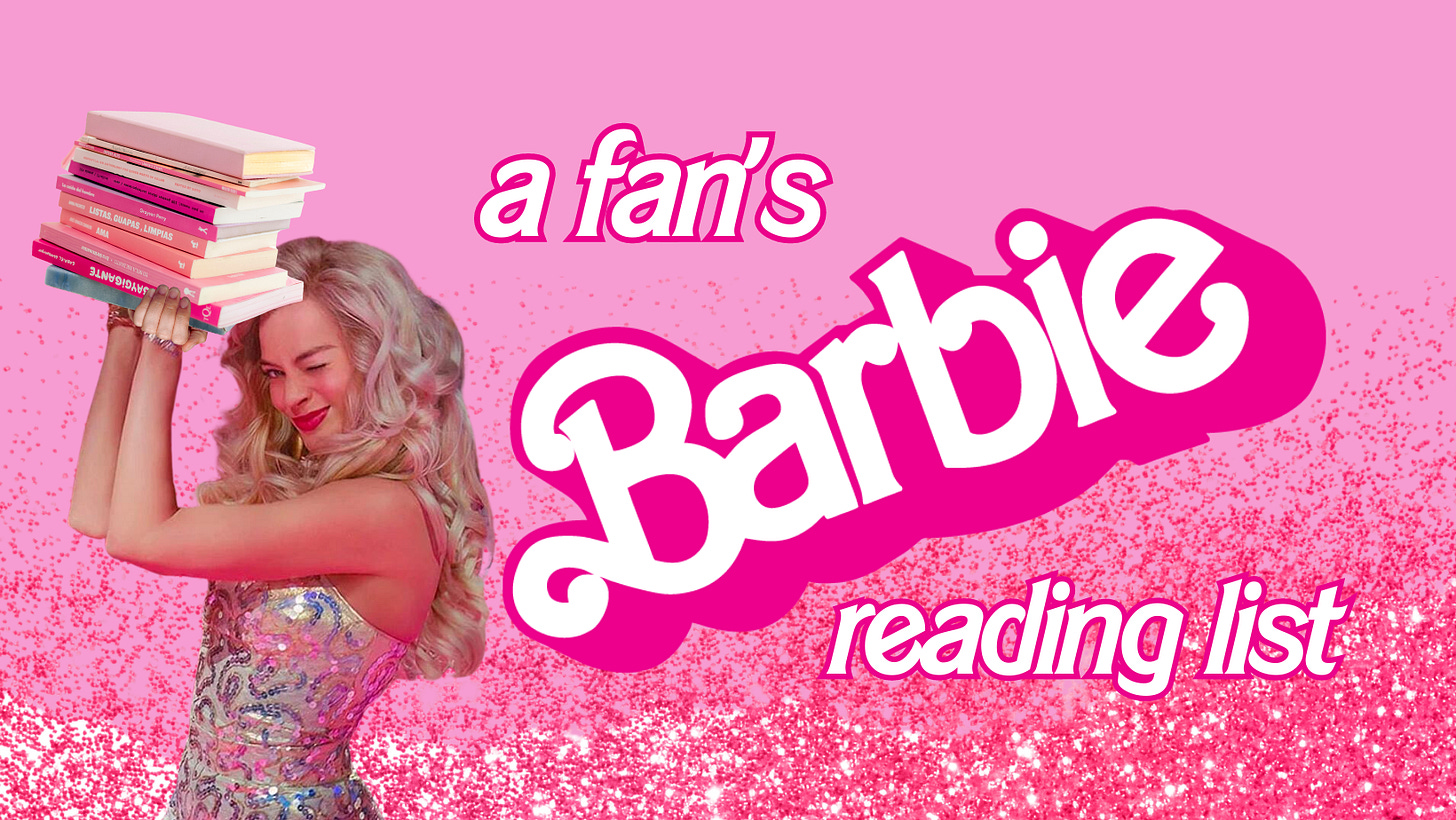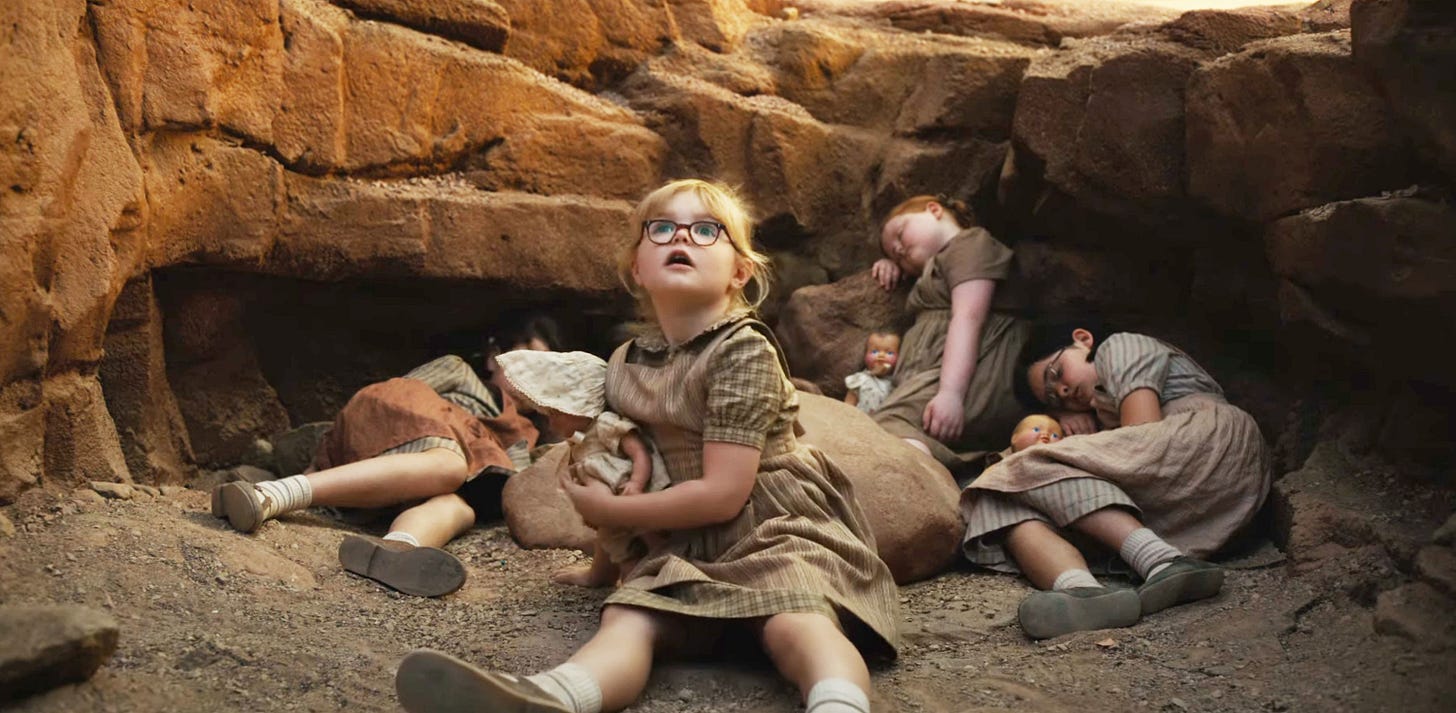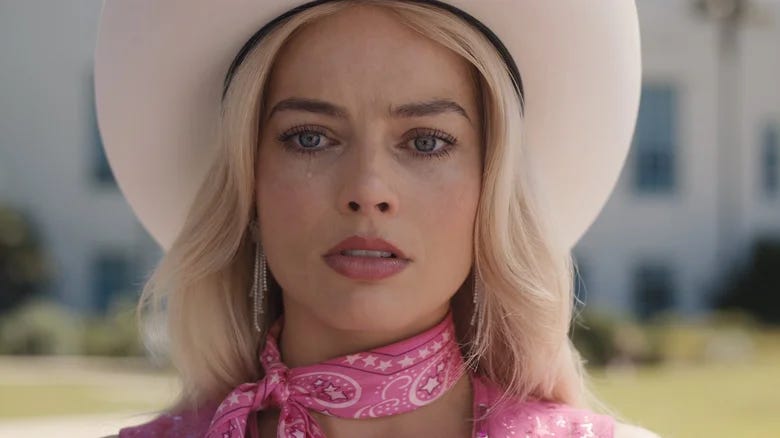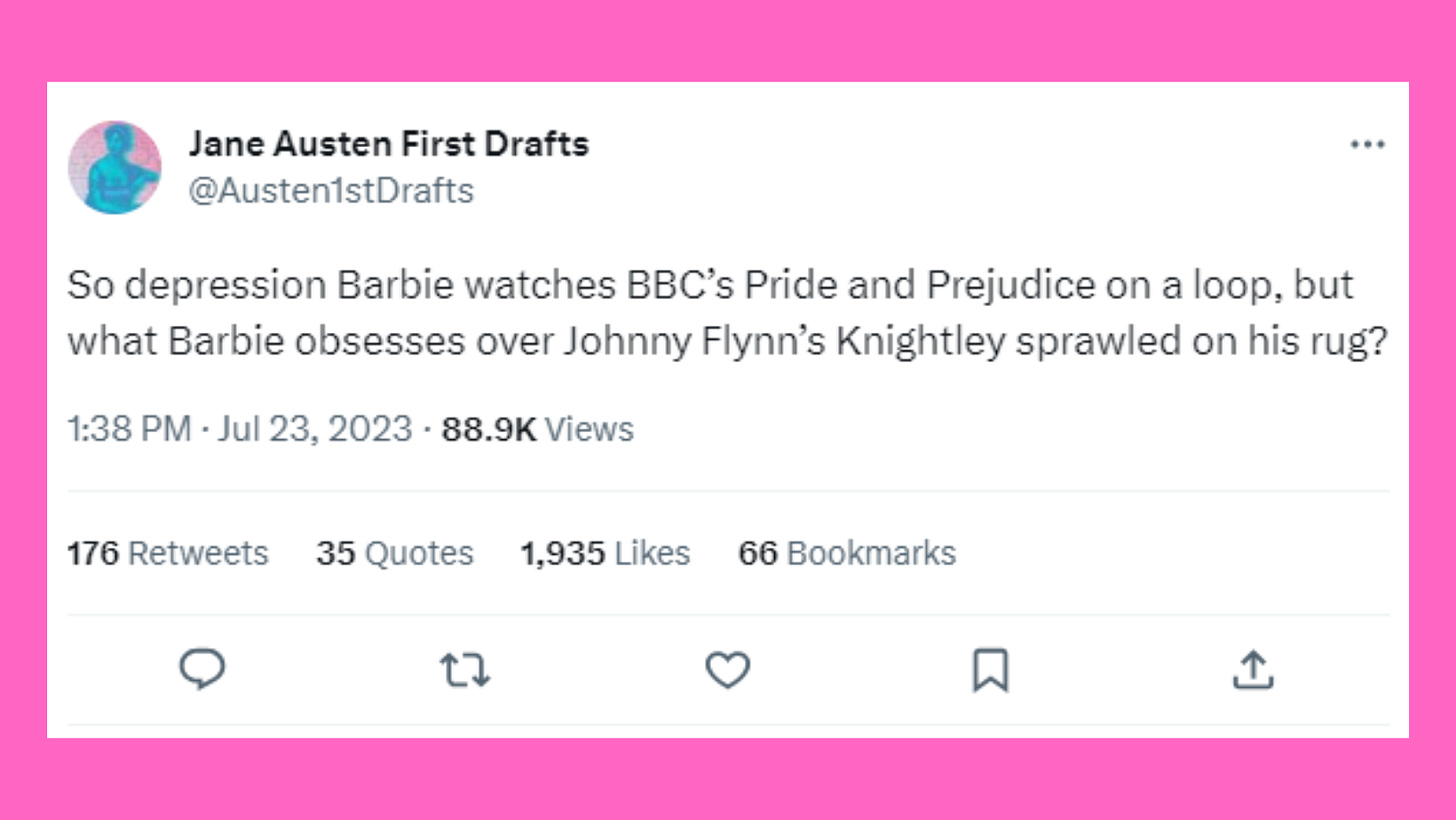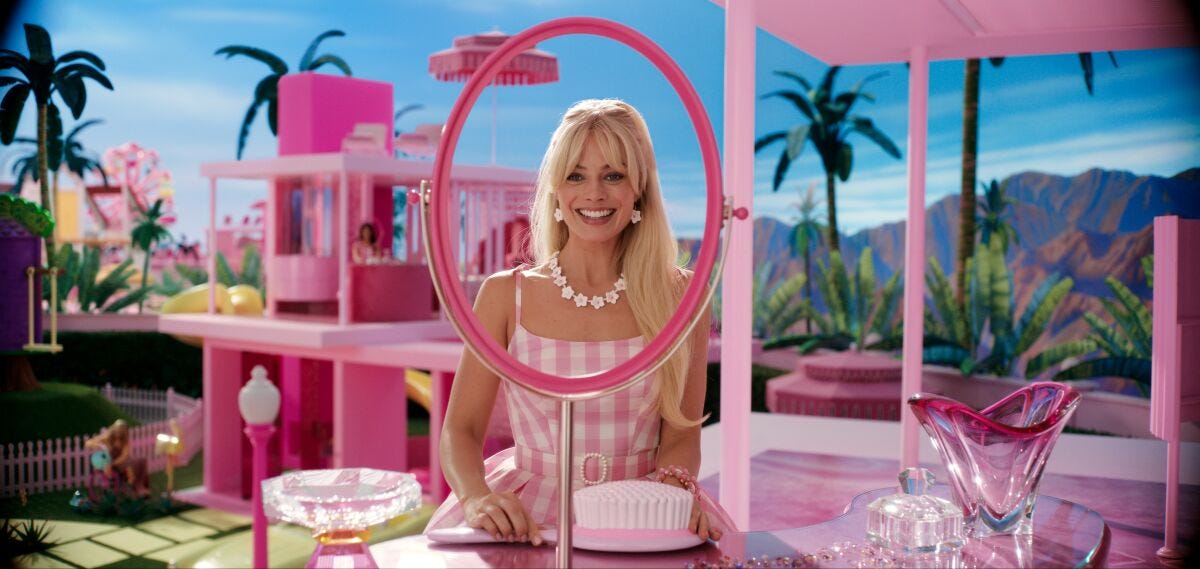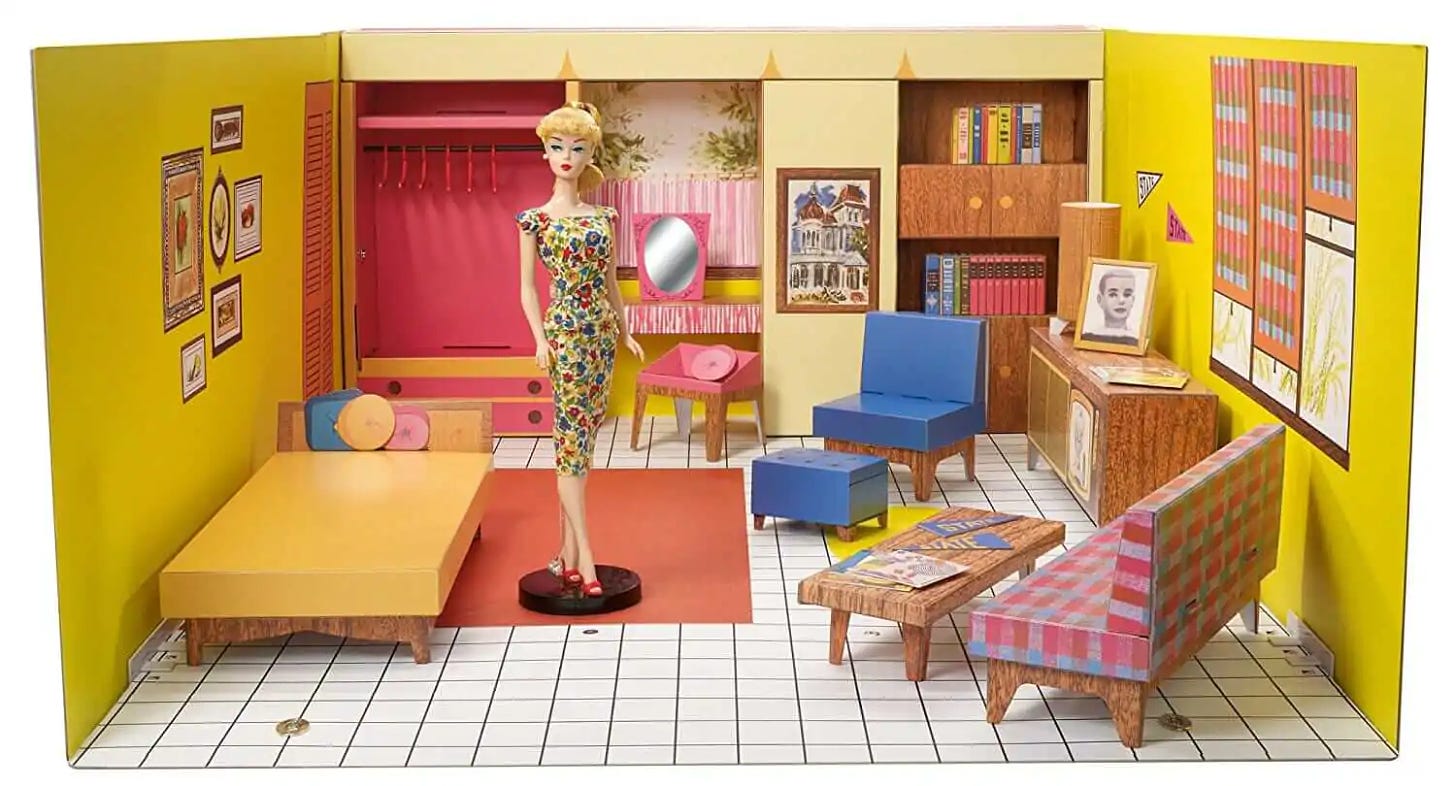It has been 48 hours since I saw Barbie and I have spent at least six of those hours watching fan reaction videos on TikTok and weeping at both the joy and the pain of the shared experiences of girlhood and womanhood in a world run by men that the movie explores. I’m doing fine!
I’ve seen some people talking about how they were surprised that the film actually had a meaningful message, and I get that. Most of the marketing has really played up the sparkly pink, bubble-gum fun most people associate with the Barbie brand. But this is also a movie written and directed by Greta Gerwig (yes, Noah Baumbach technically co-wrote it, but he’s just Ken), the filmmaker who gave us Lady Bird and the 2019 Little Women, two of my favorite movies ever and two straight-up cinematic masterpieces that even some film bros have to acknowledge as great. Those two movies also capture the experience of the transition from girlhood to womanhood in such specific and profound ways, so it’s not really surprising to me that Barbie does this also, in yet another unique way.
And I also think that being surprised that a film with a hyper-feminine aesthetic has real substance is evidence of the very societal reality that the movie is trying to point out, namely, that we don’t take girls (or “girly” things) seriously, but we should.
I’m still processing all my thoughts and feelings about Barbie, and one way that I like to mentally process media is by thinking through connections I see to other works. Sometimes those connections are through parallels of character, story, theme, or some other narrative aspect, or in a similar aesthetic or “vibe,” or occasionally just because two things remind me of each other for reasons I can’t quite put my finger on. I’ve compiled here a list of 20 books to check out for anyone who wants to further explore certain themes or ideas brought up in Barbie.
(FYI, there are a few light spoilers here, but honestly, I don’t think I’m giving away anything the average movie viewer couldn’t have predicted anyway.)
Fiction
On Girlhood
Little Women, Louisa May Alcott
Starting with what I feel is a pretty obvious choice, as Gerwig made a film adaptation of Alcott’s most popular novel, and has spoken freely about her love for the book and its influence on her. Meg, Jo, Beth, and Amy March each represent different aspects of womanhood, different ways of being a woman, and have inspired generations of girls and women and prompted countless utterances of the question “which March sister are you?” (In case anyone is interested, I’m a combination of Amy and Jo.)
So Many Beginnings, Bethany C. Morrow
If you’ve already read Little Women, may I interest you in a retelling, or “remix” as the cover states? This book recasts the Marches as a free Black family around the end of the Civil War, the same time period as the original novel. Each of the four sisters in Morrow’s story are recognizable as the March sisters, yet they are also completely their own characters. The blend of influence from Alcott, real history, and Morrow’s own storytelling make for a heartfelt and satisfying read.
Anne of Green Gables, L. M. Montgomery
Of all the “girlhood classics” I could have included on this list, this is one of the most personal to me. Anne Shirley is the whimsical, imaginative theater kid that *I* was (and still am when I’m at my best, to be quite honest) and I’m only disappointed that she was created 50ish years too early to play with Barbies, because she would have had some EPIC drama in her Barbie storytelling.
The Lion, the Witch, and the Wardrobe, C. S. Lewis
This is another choice prompted by Gerwig’s filmography, or rather future filmography, as she’s set to take on at least two films in Netflix’s adaptations of The Chronicles of Narnia. The first book in the series is notable for centering the experience of a girl, and taking that girl seriously, in a story read and beloved by all genders, not just girls—and in 1950, no less. Lucy’s point of view felt real and genuine to me when I was nine, and I can’t wait to see how Gerwig interprets it.
On Women and Patriarchy
The Edible Woman, Margaret Atwood
There are several Atwood novels that could fit the surrealist feel of the fantastical elements of Barbie, and a few that seem more overtly critical of patriarchy, but I think her first published book is the best parallel for the film. The 1969 novel’s heroine has an existential crisis that mirrors Barbie’s; after getting engaged, Marian’s view of the world as straightforward and orderly begins to shift, and she begins to identify with food as she feels her self and identity being consumed by society’s expectations.
Parable of the Sower, Octavia E. Butler
Butler’s 1993 dystopian masterpiece has been recently noted for its eerie prescience in its portrayal of the societal and political climate of the United States in the 2020s. Its teenage protagonist Lauren has hope for a better life for herself and members of her community, and she is spurred to take action toward that better life by a tragedy that forces her from her home. Lauren keeps journals in which she writes of establishing a new religion, called Earthseed, that will help humanity reach the next stage in its evolution. This exploration of spiritual themes (perhaps surprisingly, to some) mirrors the theological undertones in Barbie, which are discussed excellently in this Vox article by Alissa Wilkinson.
The Power, Naomi Alderman
If you’ve watched any of the series on Amazon but haven’t read the book yet, now is the time. Published pre-COVID and pre-#MeToo in 2016, The Power continues a tradition of feminist dystopian fiction. It imagines a world in which women develop an ability that allows them to physically overpower men en masse, ushering in a global gender role reversal and birthing a new societal order. Far from the female-centric utopia of Barbie Land, however, the new world created by women’s new power is equally as terrifying as the one we live in now.
Herland, Charlotte Perkins Gilman
Perhaps most known for her short story we all had to read in English class junior year, “The Yellow Wallpaper,” Gilman was a prolific feminist writer of the late 19th and early 20th centuries. Herland describes a utopian society made up entirely of women who reproduce asexually, and details its “discovery” by three men. The male characters find a truly Barbie Land-like social order—there is no war, conflict is resolved peaceably, and all members of society enjoy an equal share of resources. Until, of course, the men come in and f*** it up. Actually, it’s not that bad. Each of the three male characters end up representing three different, common attitudes men have toward women, even today. One of them is even a Ken.
On the Nature of Humanity
Frankenstein, Mary Shelley
Any fantastical story that deals with a human-created character grappling with their own relationship to humanity will always owe at least a small debt to Frankenstein. The scene in which Barbie looks into the eyes of her creator and questions the purpose of her existence, and finds love and acceptance, offers an opposing vision of Frankenstein’s Creature’s anger and hatred toward his maker. This parallel is especially striking in Billie Eilish’s lyrics to her song “What Was I Made For,” which plays during that scene in Barbie:
I was an ideal
Looked so alive, turns out I’m not real
Just somethin’ you paid for
What was I made for?
Never Let Me Go, Kazuo Ishiguro
A spiritual successor to Frankenstein, Ishiguro’s modern classic advances that oft-posed question in science fiction: what makes a human, human? The book follows three young people who learn that they are clones created for the sole purpose of becoming organ donors for the humans they were cloned from. Barbie is at its heart a coming-of-age film, and Never Let Me Go offers a darker vision of a similar journey of realization. As Joseph O’Neil wrote for the Atlantic when the novel was first published in 2005, the three main characters’ “hesitant progression into knowledge of their plight is an extreme and heartbreaking version of the exodus of all children from the innocence in which the benevolent but fraudulent adult world conspires to place them.”
The City We Became, N. K. Jemisin
Barbie Land is almost a character of its own in Barbie, and Jemisin’s inventive fantasy novel explores the question, what if a place literally *was* a character? In this world, cities come to life as human avatars, and the city of New York has five humans representing the five boroughs that are tasked with guarding the city against Lovecraftian monsters. Much like in Barbie, while The City We Became does have villainous characters, the true villain is an unseeable force: the reactionary impulse to oppress one group for the benefit of another. But it’s also fun, I promise!
Jane Austen, Because Of Course
Pride and Prejudice
I felt personally victimized by Greta Gerwig for Depression Barbie, who wears sweatpants all the time and rewatches the BBC Pride and Prejudice adaptation on a continuous loop. Go ahead and watch that to see what the hype is about, and then read the book, and then watch the 2005 film starring Keira Knightley (my personal fave, though I feel you, Depression Barbie, I really do.) And then if you want more Pride and Prejudice, read a retellling. Two I recommend are Pride and Protest by Nikki Payne and Ayesha At Last by Uzma Jalaluddin.
Emma
I also have to shoutout my girl Emma Woodhouse, who is handsome, clever, and rich, and was the original Barbie before Barbie ever Barbied. Emma has a dream house, a dream car(riage), and no inducements to marry. The scene in Barbie with Barbie’s magical closet was also inspired by Cher’s closet in Clueless, which is, of course, an adaptation of Emma. If you love Clueless, or even more so if you can’t stand Emma Woodhouse in any form, you should check out the Emma retelling Her Own Happiness by Eden Appiah-Kubi, which comes out this September.
Nonfiction
On Culture and Myth-Making
The Heroine’s Journey, Gail Carriger
I’ve seen a few discussions of Barbie referring to the Hero’s Journey, that ubiquitous concept in Hollywood screenwriting that Joseph Campbell probably wouldn’t even recognize now with the way it’s been mass produced. But if Barbie truly adhered to the Hero’s Journey as a plot structure, the movie would have ended when she achieved the goal of taking back Barbie Land. Instead, she moves beyond that story to one of self-realization and reflection, as well as building a network with other characters who partner with her on the journey, both of which are hallmarks of the Heroine’s Journey. There is another book called The Heroine’s Journey by Maureen Murdock that is more of a psychological approach, but Carriger, a fantasy and romance novelist, approaches the journey from a storytelling and pop culture perspective.
The Heroine With 1001 Faces, Maria Tatar
Tatar challenges that same Campbellian concept of the Monomyth that Hollywood movies tend to copy and dilute, drawing out the stories of women in both classical and popular culture myths. From fairytale heroines and their Disney-fied counterparts, to the female superheroes of comics and blockbuster films, Tatar explores the heroines that are often excluded from the discussion of the Hero’s Journey and invites us to consider the very definition of “hero” within a narrative context.
Pandora’s Jar, Natalie Maynes
I touched on Barbie the cultural icon as a Pandora variant in this TikTok, and after having seen the film, I think we can include this specific iteration of the character Barbie as a Pandora figure as well. In Greek myth, Pandora was the first human woman, created by the gods to punish human men and imbued with innate curiosity that eventually unleashes evil and suffering on the world. Barbie’s journey of self-discovery and awakening to the harsh realities of the human world and her cultural status as an ideal of womanhood both mirror aspects of Pandora’s myth. Maynes discusses Pandora, as well as several other female figures from Greek mythology, exploring their cultural contexts in both the ancient and modern worlds.
On Feminism and Independence
Bachelor Girl, Betsy Israel
Barbie owned her own house before women were legally allowed to have their own credit cards in the United States, but even before women won the right to vote, there were a few to be found living and working independently. Israel’s social history chronicles the generations of single women who have chosen to live on their own for the past century. From the “Bowery Girls” of early 20th century New York City, to the flappers of the 1920s, to the pioneering women entering career fields dominated by men in the 1960s and ‘70s, the history of independent women is reflected in Barbie’s accomplishments.
Hood Feminism, Mikki Kendall
The subtitle of this book, “Notes from the Women White Feminism Forgot,” gives a perfect snapshot of Kendall’s message. Barbie as a brand has been rightly critiqued for focusing on an overwhelmingly white depiction of femininity for most of its history, though it has made improvements in recent years and I do think the movie makes a fair attempt at greater inclusivity. Kendall provides a thorough but accessible introduction to the greatest obstacles being faced by women who are not white, straight, able-bodied, or middle class, the issues that have to be given weight for any feminist movement to be beneficial to all women.
all about love, bell hooks
hooks’ 2000 book explores the many expressions of love in modern society. The central thesis focuses on individuals improving their lives by fostering self-love, finding non-romantic love for the community, and subverting and dismantling the male-dominated social structure of patriarchy in our interpersonal relationships. Basically, creating our own Barbie Land in the real world. hooks writes in the preface,
I write of love to bear witness both to the danger in this movement [patriarchy], and to call for a return to love. Redeemed and restored, love returns us to the promise of everlasting life. When we love we can let our hearts speak.
On Barbie
The Good, the Bad, and the Barbie, Tanya Stone
There are several books, both authorized and un-, that detail the history of Barbie as a doll and a cultural icon, but I think this one offers the most succinct and insightful look at the social issues often discussed in conversations around Barbie. There are several generations of people who have grown up with a full range of emotions and attachments to Barbie, and I think this book, much like the movie Barbie, does its best to speak to those many facets. I also recommend the audiobook.
When I originally conceived of this post a couple weeks ago, it was going to be a Barbenheimer reading list, and I had pre-selected a few books that are still on this list that I anticipated would sort of straddle the thematic Venn diagram between the two films. But as it turned out, Barbie contains multitudes on its own, and I haven’t seen Oppenheimer yet. Maybe once I do I’ll make a list of lighthearted contemporary romances to read to lighten your mood.

